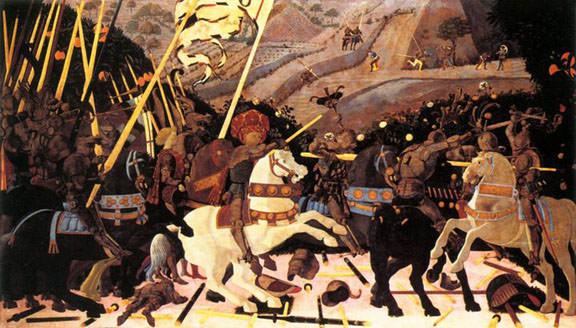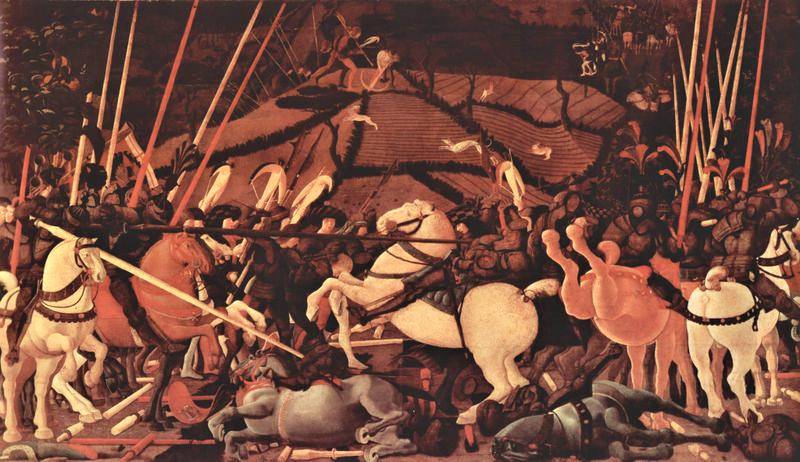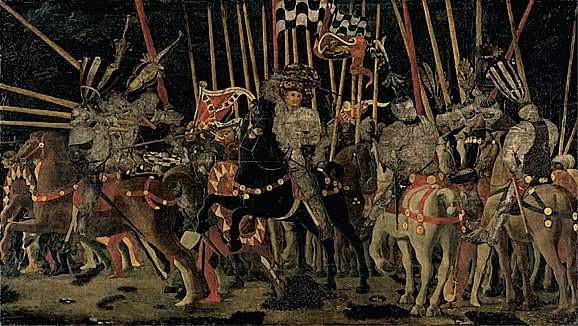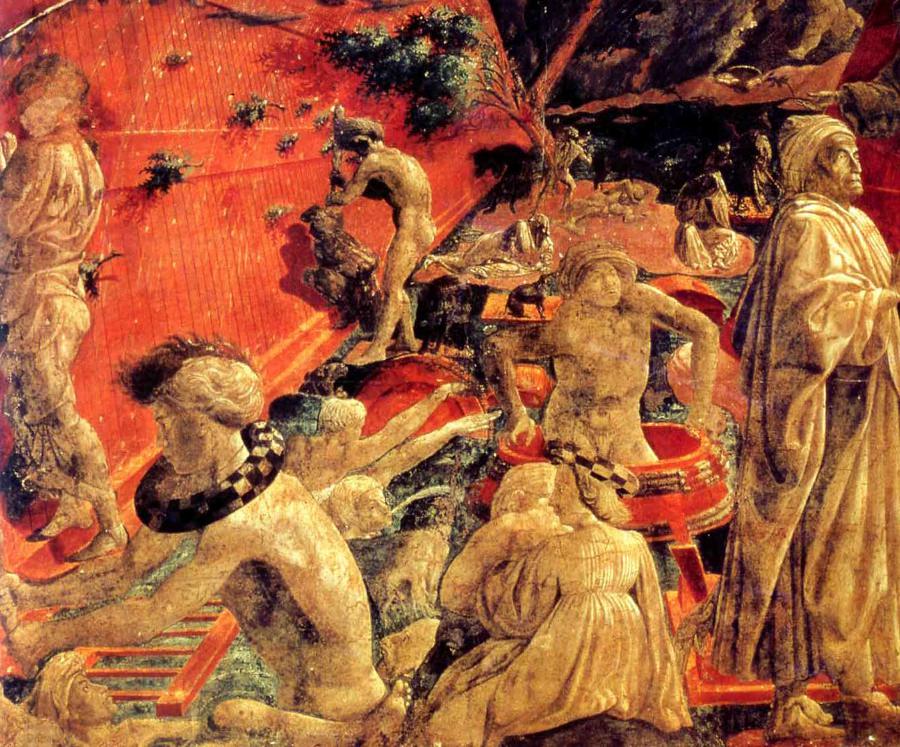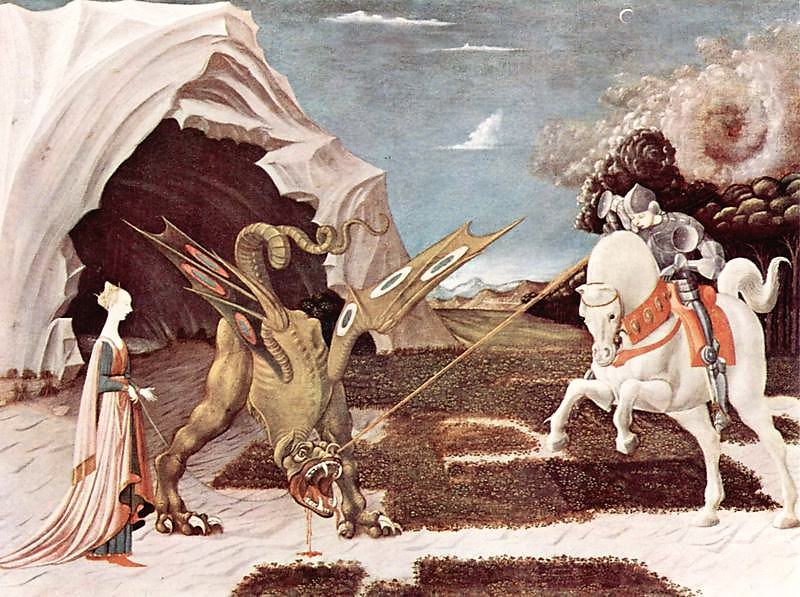Paolo Uccello.
The Battle of San Romano.
Paolo Uccello was born in Florence in 1397. He was apprenticed to the sculptor and metalworker Lorenzo Ghiberti and was admitted to the painter's guild in 1414. Paolo was also a lifelong friend of the sculptor, Donatello. He married Tomasa Malifici in 1453 and a son, Donato was born in the same year. By 1456 the couple had also produced a daughter, Antonia.
Uccello was fascinated by the new science of perspective and spent nights and days drawing objects in foreshortening. when his wife called him to come to bed he would say: "Oh what a lovely thing this perspective is!"
His most famous work is The Battle of San Romano. The Battle of San Romano was fought in 1432 between the troops of Florence, commanded by Niccolò da Tolentino, and Siena, under Francesco Piccinino. There are three panels, one in the National Gallery in London, one in the Uffizi in Florence and the final panel is in the Louvre, Paris.

Detail showing the foreshortened soldier in The Battle of San Romano.
(s)
This London version is the artist's best-preserved picture, and it clearly shows his fascination with perspective. The broken lances on the ground all point to a common vanishing point as does the fallen soldier who is foreshortened in one of the earliest examples of this type of painting.
Niccolò Mauruzi da Tolentino unseats Bernardino della Ciarda.
Personal Opinion:-
Going to be controversial here, I do not like this version. I have seen this and the one in the National Gallery in London and the difference in quality is staggering. The painting has suffered from some poor restoration and from the passage of time, it does just not seem as impressive as the London version. It is important to say what you dislike in the world of art; everyone has their own opinion. If you feel that a heap of bricks on the floor of the Tate Modern does not do it for you say so.
Uccello, The Flood and the Subsidence of the Waters.
Uccello’s painting of the Deluge is a fresco executed on the wall of a cloister in the church of Santa Maria Novella, Florence, Italy.
On each side there are fragments of the wooden ark. These are painted diagonally, dramatically reducing to a vanishing-point somewhere on the horizon. This is an extreme example of Uccello’s excellent grasp and understanding of perspective. Figures cling to the side of the ark walls in a desperate attempt to escape the waters. One climbs out of a barrel while another wears an elaborate wickerwork neck decoration. A Dante like figure stands in prayer, grateful for the receding of the waters.
Uccello has demonstrated how the use of perspective can intensify the drama of the scene. His innovations and expertise were admired and copied by subsequent generations of artists.
Personal opinion:-
A visit to the church of Santa Maria Novella is necessary for any visitor to Florence. Uccello’s fresco is one of many famous masterpieces to be seen in this wonderful building. Works by Giotto, Brunelleschi, and Filippino Lippi are among the treasures on display.
If you get the opportunity to visit this church, then I would strongly recommend that you do so.
St George and the Dragon.
Uccello’s St George and the Dragon features an elaborate reptilian looking dragon that has emerged from a cave. It is accompanied by a damsel who is far from distressed she has a tether around her waist which is attached to the neck of the dragon.
Is the fearsome monster her pet?
The narrative is that she is being held captive by the dragon as a source of food to be devoured later. The dashing, armoured St George appears on a stylised horse, he rides to the rescue slaying the dragon with his lance.
The Hunt in the Forest.
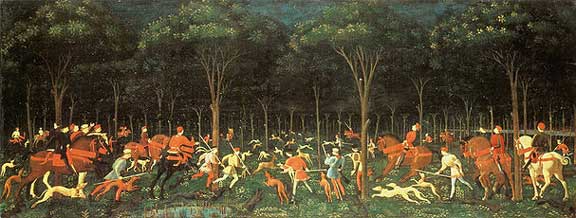 The Hunt in the Forest. 1470. Ashmolean Museum, Oxford, England. (w)
The Hunt in the Forest. 1470. Ashmolean Museum, Oxford, England. (w)The Hunt takes place among a forest of slender trees. The trees create a framework, a visual reference in which the action takes place. This is Uccello's last known painting. It shows how well he understood perspective, with the hunters, dogs and horses all disappearing into the forest in the distance. A lasting testament to a talented artist.
In his Florentine tax return of August 1469, Uccello declared: “I find myself old and ailing, my wife is ill, and I can no longer work.”
He died on 10th December 1475 aged 78.
- Home
- Paolo Uccello
